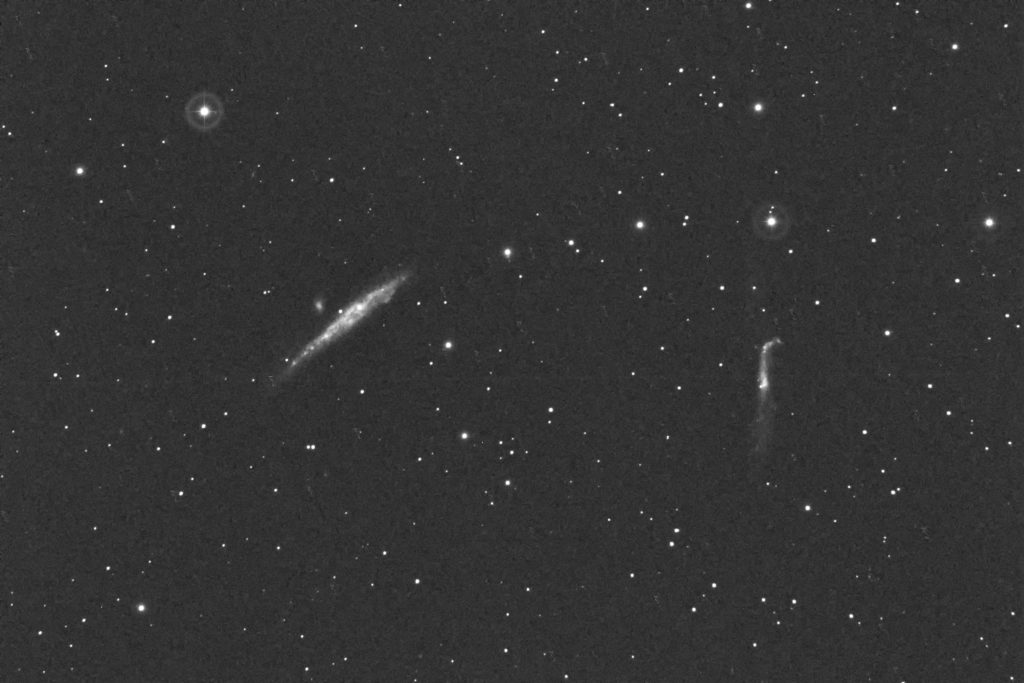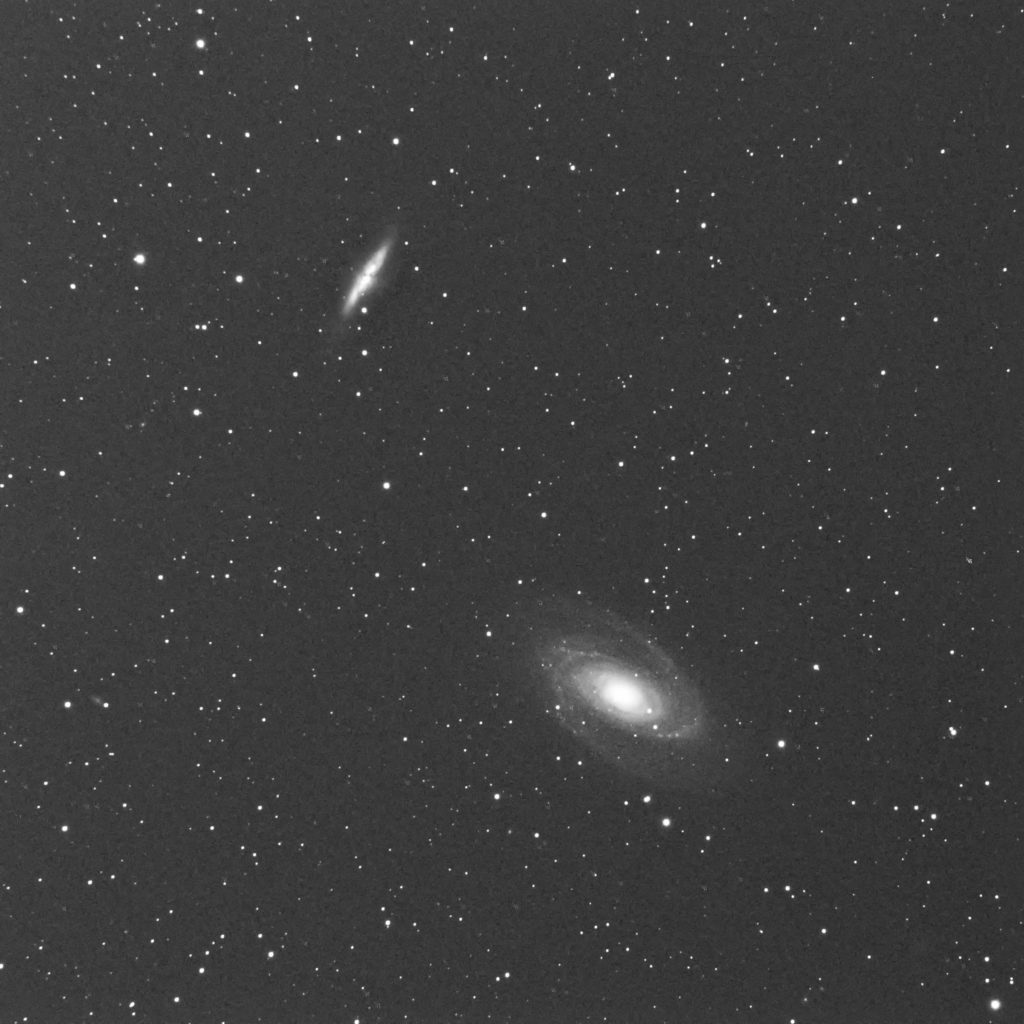
When it comes to galaxies, gravity and Newton’s first law of motion often combine to put the finest earthbound sculptors to shame. Take the galaxies NGC 2936 and NGC 2937, for instance. Here we see an everyday spiral galaxy bent and molded by the gravitational influence of a featureless elliptical companion galaxy into a graceful arc of stars and gas and dust a hundred thousand light years long. Together, the two bear a remarkable resemblance to a mother penguin holding watch over a shimmering egg. It’s one of the most beautiful galaxy pairs in the heavens.
The Penguin and Egg galaxies are just two of hundreds of pairs of gravitationally interacting galaxies flecked throughout the night sky. Their names evoke their remarkable appearance. There are the Mice Galaxies (NGC 4676), the Antennae Galaxies (NGC 4038 and NGC 4039), the famous Whirlpool Galaxy (Messier 51 and NGC 5195), the Tadpole Galaxy, the Hockey Stick Galaxy (NGC 4656), and the Whale and Pup (NGC 4631 and NGC 4627). Many of these interacting galaxies are within reach of backyard telescopes, either visually or with the help of a small camera.
The origin of these oddly-shaped galaxies was a puzzle to early 20th-century astronomers. Edwin Hubble, among his many other accomplishments, and in an attempt to understand galaxy shapes, created a system in which galaxies were classified as a spiral, or a more featureless elliptical, or something in between (a lenticular galaxy). A majority of galaxies fit Hubble’s system and more elaborate subsequent systems. But many did not, and astronomers struggled to figure out how these strange (or ‘peculiar’) galaxies fit into the scheme of things with the help of indistinct (though still impressive) images from the 100-inch Hooker Telescope at Mount Wilson and later the 200-inch Hale Telescope at Palomar Mountain.

Their puzzlement over peculiar galaxies didn’t stop astronomers from building catalogs of these objects. Which is often how science works – first catalog and classify, then try to discover the underlying dynamics to figure out what’s going on. The finest catalog of these peculiar galaxies was assembled and published by the American astronomer Halton Arp in 1966. Arp’s Atlas of Peculiar Galaxies cataloged images of 338 strange galactic assemblies that even today inspire professional and amateur astrophotographers looking for photogenic targets.
Many famous peculiar galaxies are listed in Arp’s catalog. The Penguin and Egg, for example, are collectively the 142nd object in the catalog (Arp 142). The Whirlpool Galaxy is Arp 85, the Antennae Galaxy is Arp 244, and the bright Cigar Galaxy (M82) is Arp 337. Like photographic compendiums of great artworks from the best earthbound museums, Arp’s Atlas of Peculiar Galaxies still worthy of attention and careful inspection, if only to consider what immense and astonishingly beautiful structures can arise from the relatively simple laws of gravity.
Arp himself was a little out of the ordinary. Born to artist parents in New York City in 1927, he grew up in Greenwich Village and didn’t attend school until the 5th grade. After a stint in the U.S. Navy, Arp got a rigorous astronomical education at Harvard and Caltech, eventually landing work at the latter as the 200-inch Hale telescope was commissioned. He also ranked as a champion fencer and often punctuated his scientific lectures with stylized thrusts and parries to dramatize the back and forth of the vigorous astronomical debates of the day.
Nor was Arp one to skirt controversy. He especially doubted the emerging understanding in the 1960s of a rapidly expanding universe and the Big Bang. Arp noticed that the newly discovered quasars, which were then known as point source bodies that seemed to recede at great speed, were often located next to relatively nearby galaxies on the celestial sphere. He suspected quasars were actually small luminous bodies ejected at high speed by the nearby galaxies rather than distant objects at the edge of an expanding universe. He debated his ideas vigorously, but they fell out of favor by the 1970s as evidence for an expanding universe piled up. Arp pushed the astronomical establishment a little too hard, and he eventually lost his research time on the big American telescopes. He later moved to the Max Planck Institute in Munich and died there in 2013, questioning the idea of an expanding universe until the end.

As with his idea about quasars, Arp believed many of the peculiar galaxies in his catalog were objects ejected from larger structures. But again he was off the mark. We now understand that most of these peculiar galaxies are regular spiral or elliptical galaxies that disrupt themselves as they pull close to each other. Observations show that each galaxy in an interacting pair lies at a similar distance and in close proximity to each other, and some of the interacting galaxies appear to resemble scrambled versions of more regular galaxies. Some of these galaxies pass close enough to change their shape and ignite a bout of star formation as their gas clouds are gravitationally compressed. Others suffer near collision and significant disruption. Other pairs eventually merge into a single galaxy after repeated interactions.
As further evidence, sophisticated simulations of interacting galaxies seem to be successful in reproducing the observed shapes of Arp’s peculiar galaxies. Astronomers supply approximations of the mass, composition, and velocity of each galaxy to a supercomputer, press ‘go’, and turn the results into mesmerizing video animations that show the entire galactic dance. Computer-modeled variations of galaxy pairs that collide directly, or endure glancing blows, or simply jostle each other from a respectful distant have all been tested and appear to reproduce the beautiful galactic rings, loops, arcs, and streamers we see through a telescope. Of course, we see just a snapshot of the overall interaction: these galaxies remain entangled for tens of millions of years.
Galactic interactions occur more frequently in densely-packed clusters of galaxies. But our own sparsely-populated Local Group is not immune. Our Milky Way, astronomers believe, will in about 5 billion years collide and merge with the slightly larger Andromeda Galaxy and form a larger and less photogenic galaxy. The smaller Triangulum Galaxy will also get pulled in eventually. As the Milky Way and Andromeda collide, they will put on a dazzling display of galactic interaction (see video above). The stars in these galaxies will not collide – there’s too much space between them for that – but the approaching galaxies will enjoy a flurry of new star formation before eventually merging into a more featureless and much larger galaxy. During their long gravitational dance, perhaps the Milky Way and Andromeda will come to resemble an animal or implement or artifact from a civilization unimaginably different from our own, one where alien astronomers train their telescopes on the remains of two stately spirals in a distant time when our Earth and Sun are long expired.
Share This: